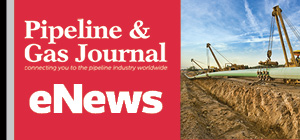March 2025, Vol. 252, No. 3
Features
With Costs at Twice the Price of Steel, ‘Common Sense’ Encouraged
35339By Mary Holcomb, Digital Editor
(P&GJ) — Williams Cos. CEO Alan Armstrong says permitting costs have become a bigger burden than potential tariffs, revealing that for one of the company’s projects, the cost of securing permits was twice the price of building the pipeline itself.
Speaking at CERAWeek by S&P Global on March 12, Armstrong noted that he would prefer a 25% tariff if it meant expediting the permitting process, emphasizing how regulatory hurdles are delaying critical infrastructure.
“On one of our current projects, the permitting costs alone are twice as much as what we’re spending on the pipe itself,” Armstrong said. “And that’s if everything goes well – if there are no legal battles or delays. The risk of spending hundreds of millions of dollars on a project that could be halted due to regulatory challenges raises the cost of capital and, ultimately, costs for consumers.”
Armstrong stressed that political and regulatory challenges – not resource scarcity – remain the biggest barrier to energy expansion. While the U.S. has an abundance of technically recoverable natural gas, the real challenge lies in making those resources politically recoverable.
“There is so much value to be unlocked for our country if we fix this issue,” Armstrong said. “We need a permitting system that allows us to build efficiently and predictably, instead of being mired in endless bureaucracy. The way we're going to succeed globally is by delivering low-cost solutions. And we can't do that if we're spending twice as much on permitting as we are on the actual infrastructure.”
Beyond the rising costs, Armstrong emphasized that policy constraints are undermining the U.S.'s ability to remain competitive in global energy markets.
“It's amazing to me that not all governments recognize the importance of enabling more infrastructure competition,” he said. “If we had the ability to overbuild infrastructure, to let companies like ours compete and build, consumers would win. That’s the right answer for energy security and affordability, yet we continue to see policymakers constrain development, which is the wrong answer for consumers and the wrong answer for the environment.”
Momentum for Reform
While Armstrong remains optimistic that permitting reform is gaining traction, he emphasized that the industry must continue to push for regulatory clarity.
“The good news is, I think we’re seeing some common sense start to take hold on this issue," he said. “But we have to do our part as an industry to put a voice to that – to that very noisy middle that we need to bring common sense back to building national infrastructure here in the U.S.”
Armstrong also noted that energy infrastructure challenges extend beyond the gas industry. Demand from AI, data centers, and manufacturers is putting additional pressure on power grids – creating an urgent need for long-term investment in pipelines and natural gas supply chains.
“We’re seeing AI and data centers demand more power, and they need reliable, low-cost energy,” he said. “Governors are responding to the fact that in certain areas where they’ve prohibited pipelines, they’re losing out on having tech and data centers in their area.”
Armstrong’s call for a more rational regulatory approach aligns with recent political shifts. In January, the Federal Energy Regulatory Commission (FERC) reinstated the certificate for Williams’ Transco Pipeline expansion, signaling a shift in policy under the Trump administration’s return to office.
The expansion, one of the largest under construction in the U.S. Northeast, is expected to provide enough gas to serve 4.4 million homes annually – an example of the type of infrastructure investment Armstrong argues is essential for the country’s energy future.
He concluded: “We need to be smarter about how we approach energy infrastructure, ensuring that we support the policies and investments that allow us to deliver reliable, affordable energy – both for U.S. consumers and for global markets.
It’s time for common sense to prevail in energy policy, and for us to build the infrastructure that will define the next era of energy security.”







Comments